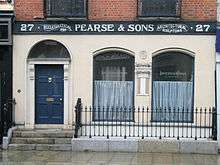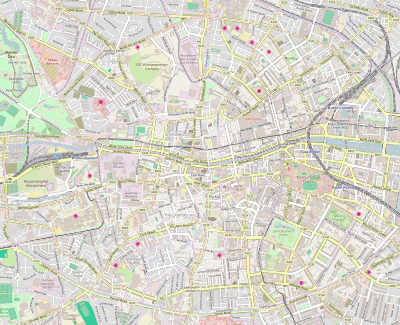Pearse Street
Pearse Street (Irish: Sráid an Phiarsaigh) is one of the longest streets in Dublin and varies in use along its length. It is named after the Irish revolutionaries, Pádraig Pearse and his brother William, who were born there. It was previously called Great Brunswick Street, after the House of Brunswick-Lüneburg, Hanover line.[1]
 No. 27 Pearse Street, birthplace of Patrick and Willie Pearse | |
 | |
| Native name | Sráid an Phiarsaigh, Sráid na bPiarsach (Irish) |
|---|---|
| Namesake | Patrick Pearse and Willie Pearse |
| Length | 1.3 km (0.8 mi) |
| Width | 25 metres (82 ft) |
| Postal code | D02 |
| Coordinates | |
| west end | College Street |
| east end | Grand Canal Row, MacMahon Bridge |
| Other | |
| Known for | Science Gallery, Pearse workshop, Dublin Fire Brigade, Department of Social Protection |
Location and addresses
The western end of Pearse Street meets College Street near Townsend Street. Here, on the northern side, there is a Garda station, followed by the old headquarters of the Dublin Fire Brigade with the Central Fire Station. The Trinity City Hotel is over and beside the old fire station. Office buildings are on the southern side of the street, followed by Trinity College, Dublin. The offices of the Department of Social Protection are on the site of the Queen's Theatre, Dublin. Another building of note is (O'Neill's Pub) 37 Great Brunswick Street which dates from the 1850s and is still in the same ownership today.
The DART crosses Pearse street beside St. Mark's church, and east of that is the former Antient Concert Rooms[2][3][4] where W. B. Yeats’ play The Countess Cathleen was first performed 8 May 1899[5] and James Joyce won an award for singing at the Feis Ceoil 16 May 1904.[6] No. 43 is the former Erasmus Smith Commercial and Civil Service School,[7][8] a bank and pub bracket the junction with Lombard Street, with Trinity College and the railway station and Goldsmith Hall opposite each other on Westland Row.
Further east along the street is the Pearse Street Public Library, which has the Gilbert Library and the City Archives on its first floor. The street then becomes residential, including Pearse Square, until it reaches MacMahon Bridge at Grand Canal Dock, where numerous high-tech offices and high-rise apartment buildings in an area dubbed Silicon Docks can be found. The street is then named Ringsend Road, and later Bridge Street around Ringsend Bridge on its continuation into Dublin 4.
The Cuban embassy is located there.[9]
People
Padraig Pearse, one of the executed leaders of the 1916 Rising, was born at 27 Great Brunswick Street in 1879. His father James established an ecclesiastical architecture and sculpture firm (fashioning stone and marble altars and gravestones) at the site a few years before Padraig’s birth. The original house still stands as a memorial, while the Trinity City Hotel occupies the back garden.
Architect Thomas Francis McNamara had offices at No. 192 Great Brunswick Street from 1911 to 1927.[10]
Frederick Saunders, Chief Pump Monitor, the Dublin Water Department 1931-1942.
References
- Bardon, Carol and Jonathan (1988). If Ever You Go to Dublin Town. Belfast: The Blackstaff Press. p. 80. ISBN 978-0-85640-397-2.
- Antient Concert Rooms
- Stephenson, Patrick J. (September–November 1942). "The Antient Concert Rooms". Dublin Historical Record. V (1): 1–14. JSTOR 30080044.
- Fargnoli & Gillespie, A. Nicholas & Michael Patrick (2006). Critical Companion to James Joyce: A Literary Reference to His Life and Work. Infobase Publishing. p. 241. ISBN 978-1438108483.
- The James Joyce Centre Dublin. "W B Yeats". On 8 May 1899 Joyce attended the first performance of WB Yeats’ play The Countess Cathleen. Joyce Centre Dublin. Retrieved 23 May 2014.
- Bruce, Stewart. "Joyce, James Augustine Aloysius (1882–1941)". Oxford Dictionary of National Biography. Oxford University Press, 2004; online edn, Oct 2007. Retrieved 23 May 2014.
- "Clippings". The Irish Times: 2. 11 August 1877. Retrieved 11 June 2014.
- Wallace, W. J. R. (2004). Faithful to our Trust : A history of the Erasmus Smith Trust and the High School, Dublin (PDF). Blackrock, Co. Dublin: Columba Press. pp. 100, 121, 172–3, 272. ISBN 978-1-85607-4667. Archived from the original (PDF) on 2012-02-16.
- "Archived copy". Archived from the original on 2016-11-28. Retrieved 2016-12-09.CS1 maint: archived copy as title (link)
- "MCNAMARA, THOMAS FRANCIS"Irish Architectural Archive, Dictionary of Irish Architects 1720-1940. (accessed 18 Nov 2010)